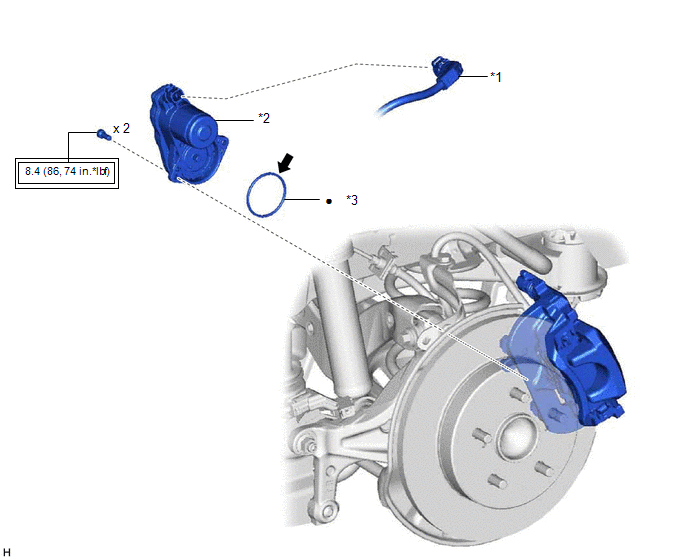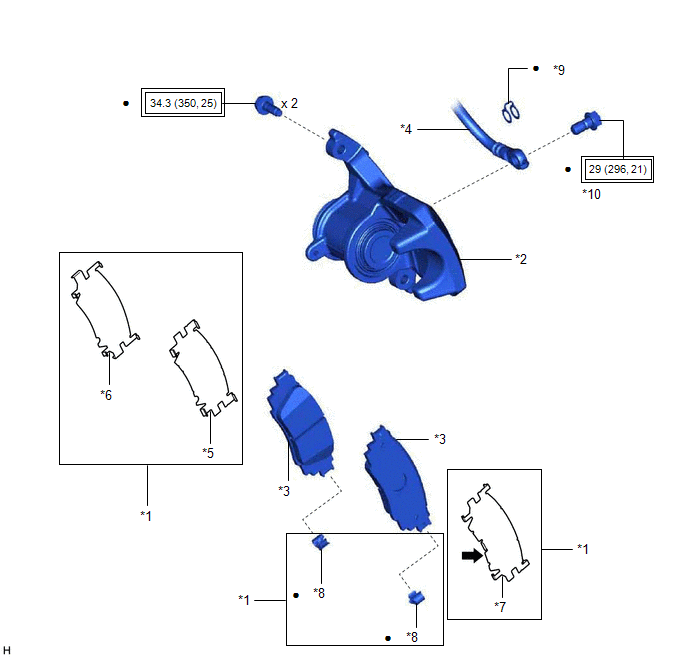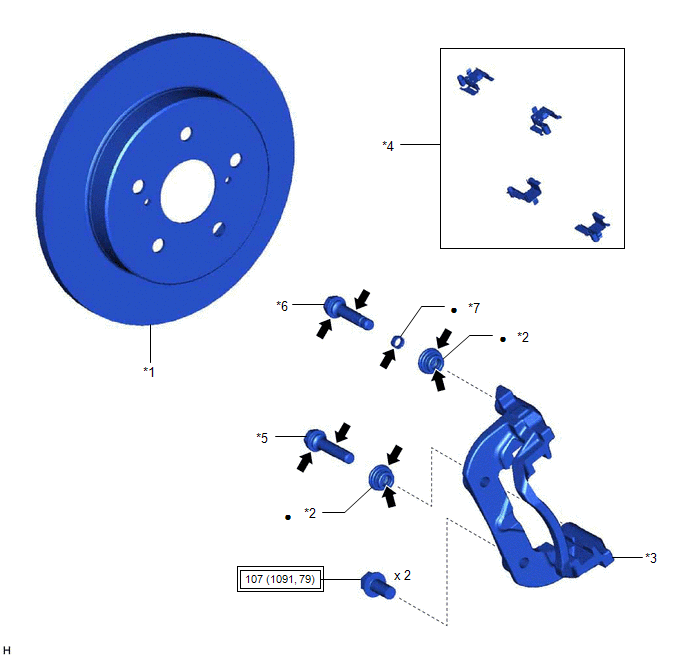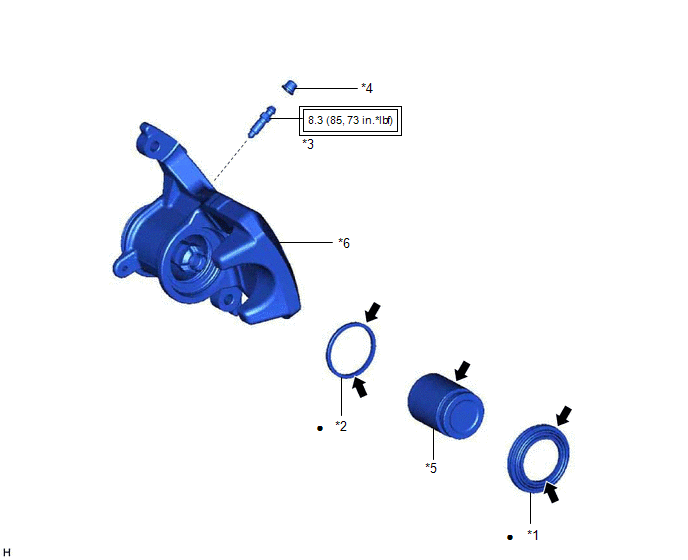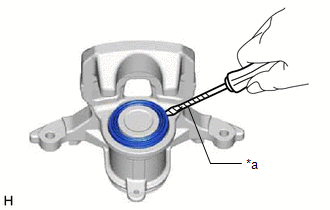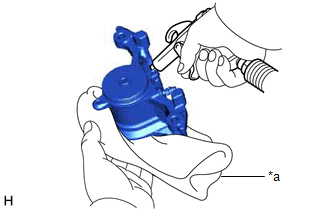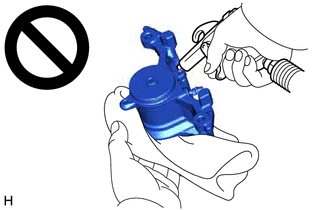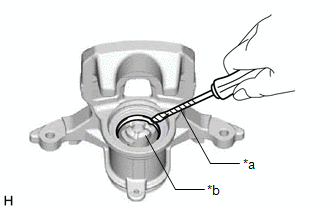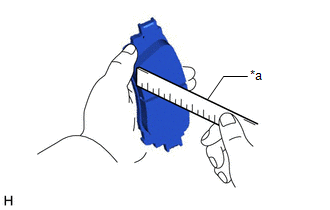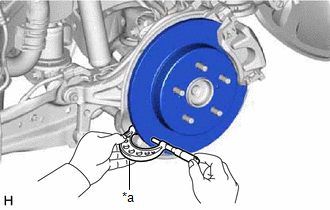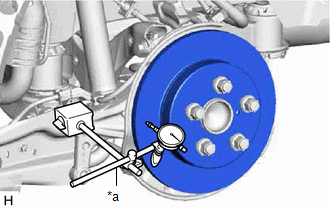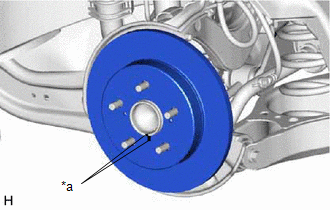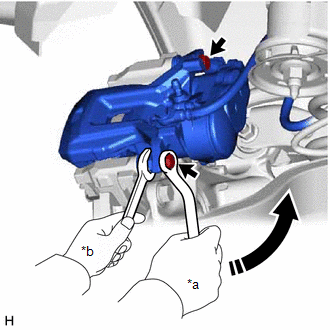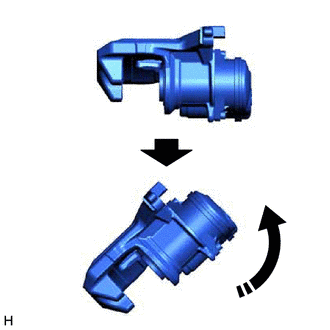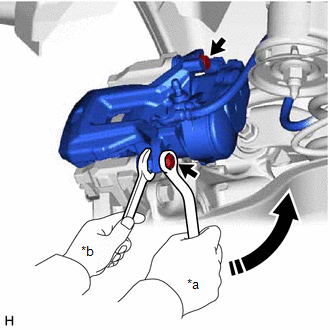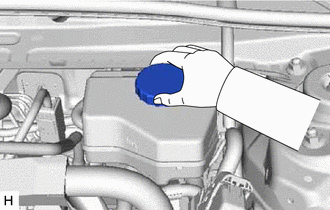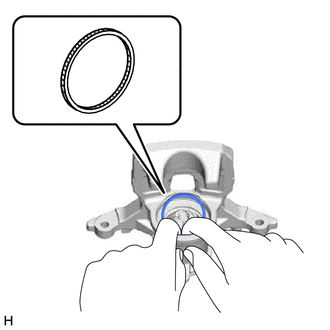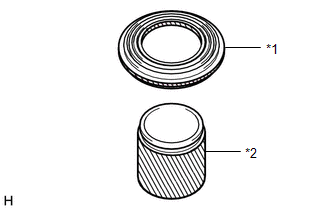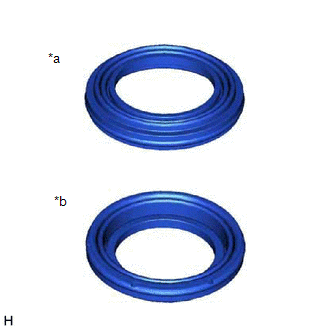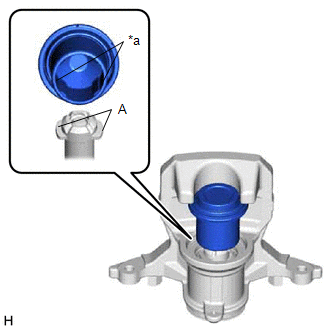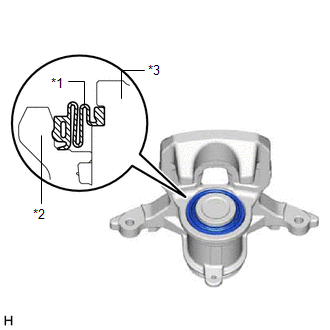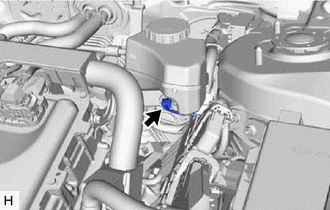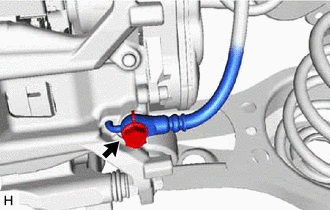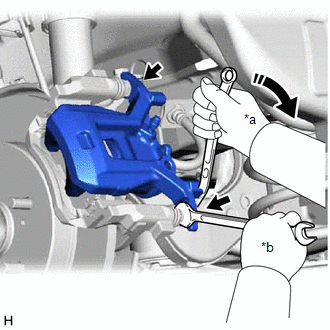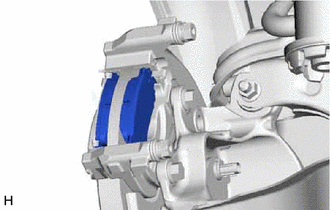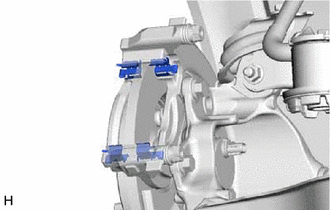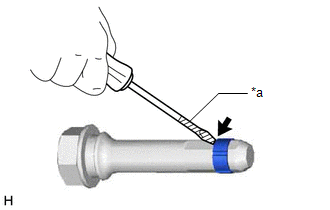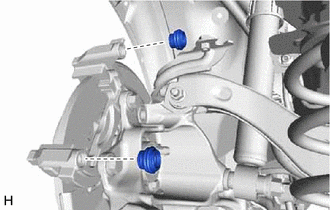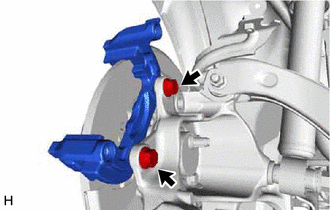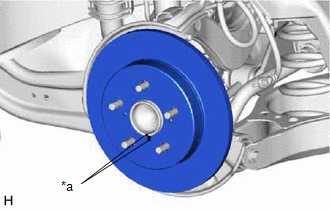Installation
INSTALLATION
CAUTION / NOTICE / HINT
NOTICE:
- Immediately after installing the brake pads, the braking performance may
be reduced. Always perform a road test in a safe place while paying
attention to the surroundings.
- After replacing the rear disc brake pads, always perform a road test to check the braking performance and check for vibrations.
- When the brake pedal is first depressed after replacing the brake pads
or pushing back the disc brake piston, DTC C1214 may be stored. As there
is no malfunction, clear the DTC. (for HV Model)
- While the auxiliary battery is connected, even if the power switch is
off, the brake control system activates when the brake pedal is
depressed or any door courtesy switch turns on. Therefore, when
servicing the brake system components, do not operate the brake pedal or
open/close the doors while the auxiliary battery is connected. (for HV
Model)
HINT:
- Use the same procedure for the RH side and LH side.
- The following procedure is for the LH side.
PROCEDURE
1. INSTALL REAR DISC
| (a) Align the matchmarks of the rear disc and rear axle hub and bearing assembly, and install the rear disc.
NOTICE: When replacing the rear disc with a new one, select the installation position where the rear disc has minimal runout. |
|
2. INSTALL REAR DISC BRAKE CYLINDER MOUNTING
(a) Install the rear disc brake cylinder mounting to the rear axle carrier sub-assembly with the 2 bolts.
Torque:
107 N·m {1091 kgf·cm, 79 ft·lbf}
3. INSTALL REAR DISC BRAKE BUSHING DUST BOOT
(a)
Apply a light layer of lithium soap base glycol grease to the entire
circumference of 2 new rear disc brake bushing dust boots.
HINT:
Apply more than 0.3 g (0.01 oz) of lithium soap base glycol grease to each rear disc brake bushing dust boot.
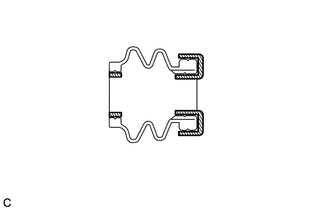
 | Lithium Soap Base Glycol Grease |
(b) Install the 2 rear disc brake bushing dust boots to the rear disc brake cylinder mounting.
4. INSTALL REAR DISC BRAKE CYLINDER SLIDE PIN
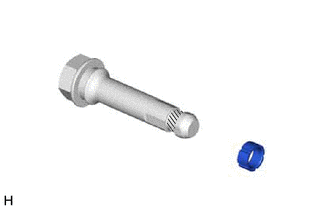
 | Lithium Soap Base Glycol Grease |
(a)
Apply a light layer of lithium soap base glycol grease to the contact
surface of the rear No. 2 disc brake cylinder slide pin.
(b) Install a new rear disc brake cylinder slide bushing to the rear No. 2 disc brake cylinder slide pin.
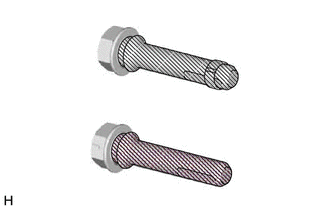
 | Lithium Soap Base Glycol Grease |
(c)
Apply a light layer of lithium soap base glycol grease to the sliding
part and the sealing surfaces of the rear No. 1 disc brake cylinder
slide pin and rear No. 2 disc brake cylinder slide pin.
| (d)
Install the rear No. 1 disc brake cylinder slide pin and rear No. 2
disc brake cylinder slide pin to the rear disc brake cylinder mounting. |
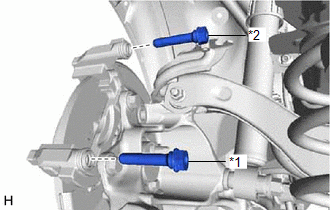 |
|
*1 | Rear No. 1 Disc Brake Cylinder Slide Pin | |
*2 | Rear No. 2 Disc Brake Cylinder Slide Pin | | |
(e)
Push the rear No. 1 disc brake cylinder slide pin and rear No. 2 disc
brake cylinder slide pin into each rear disc brake bushing dust boot to
engage the pins to the boots.
5. INSTALL REAR DISC BRAKE PAD SUPPORT PLATE
(a) Install the 4 rear disc brake pad support plates to the rear disc brake cylinder mounting.
NOTICE:
Be sure to install each rear disc brake pad support plate in the correct position and direction.
6. INSTALL REAR DISC BRAKE ANTI-SQUEAL SHIM KIT
Click here

7. INSTALL REAR DISC BRAKE PAD
(a) Install the 2 rear disc brake pads to the rear disc brake cylinder mounting.
NOTICE:
Install
the rear disc brake pad so that the rear disc brake pad wear indicator
plate is mounted on the lower side of the vehicle.
HINT:
If the rear disc brake pad has an identification mark, be sure to confirm the installation location.
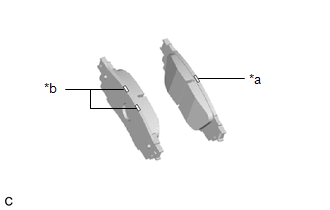
|
*a | Inner Side (White) |
|
*b | Outer Side (White) |
8. INSTALL REAR DISC BRAKE CYLINDER ASSEMBLY
(a)
Hold the 2 rear disc brake cylinder slide pins, and install the rear
disc brake cylinder assembly to the rear disc brake cylinder mounting
with 2 bolts.
Torque:
34.3 N·m {350 kgf·cm, 25 ft·lbf}
NOTICE:
If
bleeding of air from the rear brake cylinder assembly will be
performed, reuse the bolts. If bleeding of air from the rear brake
cylinder assembly will not be performed, install new bolts.
9. INSTALL PARKING BRAKE ACTUATOR ASSEMBLY
Click here 
10. CONNECT NO. 2 PARKING BRAKE WIRE ASSEMBLY
Click here 
11. CONNECT REAR FLEXIBLE HOSE
(a) Connect the rear flexible hose to the rear disc brake cylinder assembly with a new union bolt and a new gasket.
Torque:
29 N·m {296 kgf·cm, 21 ft·lbf}
NOTICE:
Install the rear flexible hose lock securely into the lock hole in the rear disc brake cylinder assembly.
12. CONNECT CABLE TO NEGATIVE AUXILIARY BATTERY TERMINAL (for HV Model)
(a) Connect the reservoir level switch connector.
(b) Connect the cable to the negative (-) auxiliary battery terminal.
Click here 
(c) Perform the following procedure if air bleeding is not necessary:
(1) Turn the power switch on (READY).
(2) Depress the brake pedal and release it.
(3) Clear the DTCs.
Click here 
13. BLEED BRAKE LINE
for Gasoline Model: Click here

for HV Model: Click here

14. BLEED REAR DISC BRAKE CYLINDER ASSEMBLY (for Gasoline Model)
CAUTION:
If the rear disc brake cylinder assembly has been disassembled, perform air bleeding for the rear disc brake cylinder assembly.
HINT:
- Use the same procedure for the RH side and LH side.
- The following procedure is for the LH side.
- While performing air bleeding of the rear disc brake cylinder assembly,
the bolts can be reused during the bleeding procedure. After air
bleeding is complete, replace the bolts with new ones.
(a) Perform the procedure to enter rear disc brake pad replacement mode 5 times.
Click here 
(b) Release the parking brake.
(c) Disconnect the No. 2 parking brake wire assembly connector from the parking brake actuator assembly.
| (d)
Hold the 2 rear disc brake cylinder slide pins and remove the 2 bolts
and separate the rear disc brake cylinder assembly from the rear disc
brake cylinder mounting.(*1) | |
| (e)
Hold the rear disc brake cylinder assembly horizontally, then tilt it
45° toward the bleeder plug side as shown in the illustration.(*2) |
|
(f) Temporarily install the rear disc brake cylinder assembly to the rear disc brake cylinder mounting with the 2 bolts.(*3)
(g) Remove the brake master cylinder reservoir filler cap assembly.
(h) Add brake fluid to keep the level between the MIN and MAX lines of the reservoir while bleeding the brakes.
NOTICE:
- Make sure that there is sufficient brake fluid in the reservoir.
- Do not remove the filter from the brake master cylinder reservoir
assembly and be sure to fill the brake master cylinder reservoir
assembly with new brake fluid to avoid any potential contamination of
the brake system. Contamination, for example by dirt particles or
mineral oil, could lead to functional brake problems.
- If brake fluid leaks onto any painted surface, immediately wash it off.
(i) Remove the rear disc brake bleeder plug cap.
(j) Connect a vinyl tube to the rear disc brake bleeder plug.
(k) Depress the brake pedal several times, and then loosen the rear disc brake bleeder plug with the pedal depressed.(*4)
(l) When fluid stops coming out, tighten the rear disc brake bleeder plug and release the brake pedal.(*5)
NOTICE:
Repeat steps (*4) through (*5) until there are no signs of air in the brake fluid.
(m) Repeat steps (*1) through (*5) 3 times.
NOTICE:
If
there is still air in the system after performing steps (*1) through
(*5) 3 times, repeat the steps (*1) through (*5) until the air has been
bled.
(n) Tighten the rear disc brake bleeder plug completely.
Torque:
8.3 N·m {85 kgf·cm, 73 in·lbf}
(o) Install the rear disc brake bleeder plug cap.
(p)
Hold the 2 rear disc brake cylinder slide pins, and install the rear
disc brake cylinder assembly to the rear disc brake cylinder mounting
with 2 new bolts.
Torque:
34.3 N·m {350 kgf·cm, 25 ft·lbf}
(q) Connect the No. 2 parking brake wire assembly connector to the parking brake actuator assembly.
(r) Inspect for brake fluid leaks.
(s) Inspect the brake fluid level in the reservoir.
Click here 
(t) Install the brake master cylinder reservoir filler cap assembly.
15. BLEED REAR DISC BRAKE CYLINDER ASSEMBLY (for HV Model)
CAUTION:
If the rear disc brake cylinder assembly has been disassembled, perform air bleeding for the rear disc brake cylinder assembly.
NOTICE:
- Perform air bleeding while maintaining the brake fluid level between the MAX and MIN lines on the brake fluid reservoir.
- Do not allow brake fluid to contact any painted surface. If brake fluid leaks onto any painted surface, immediately wash it off.
HINT:
- Use the same procedure for the RH side and LH side.
- The following procedure is for the LH side.
- While performing air bleeding of the rear disc brake cylinder assembly,
the bolts can be reused during the bleeding procedure. After air
bleeding is complete, replace the bolts with new ones.
(a) Perform the procedure to enter rear disc brake pad replacement mode 5 times.
Click here 
(b) Release the parking brake.
(c) Force air within the rear disk brake cylinder assembly to accumulate at the rear disk brake bleeder plug.(*1)
(1) Disable brake control.
Click here 
(2) Disconnect the No. 2 parking brake wire assembly connector.
Click here

| (3)
Hold the 2 rear disc brake cylinder slide pins and remove the 2 bolts
and separate the rear disc brake cylinder assembly from the rear disc
brake cylinder mounting. | |
| (4)
Hold the rear disc brake cylinder assembly horizontally, then tilt it
45° toward the bleeder plug side as shown in the illustration. | |
(5) Temporarily install the rear disc brake cylinder assembly to the rear disc brake cylinder mounting with the 2 bolts.
(6) Connect the No. 2 parking brake wire assembly connector.
Click here

(7) Connect the reservoir level switch connector.
(8) Connect the cable to the negative (-) auxiliary battery terminal.
Click here

(9) Turn the power switch on (READY).
(10) Depress the brake pedal and release it.
(11) Apply the parking brake.
(d) Enter ECB (Electronically Controlled Brake system) Invalid Mode.(*2)
NOTICE:
- Performing the following procedure enters ECB (Electronically Controlled
Brake system) Invalid Mode without using the Techstream.
- ECB (Electronically Controlled Brake system) Invalid Mode allows the brake lines to be bled without using the Techstream.
- The brake warning light blinks (yellow) to indicate that ECB (Electronically Controlled Brake system) Invalid Mode is selected.
- Be sure to confirm that the brake warning light is blinking (yellow) throughout the brake line bleeding procedure.
- If any of the following conditions are met, ECB (Electronically
Controlled Brake system) Invalid Mode is canceled and the brake warning
light (yellow) turns off. Do not allow ECB (Electronically Controlled
Brake system) Invalid Mode to be canceled while bleeding the brake lines
or DTCs may be stored.
|
The shift lever is moved from P to any other position.
|
|
The power switch is turned on (READY). |
|
The power switch is turned off. |
|
The parking brake is released. |
|
The vehicle speed is more than 0 km/h (0 mph). |
- Do not rotate any brake disc while ECB (Electronically Controlled Brake system) Invalid Mode is selected.
- Although the brake warning light (yellow) will blink and a buzzer will
sound while performing brake line bleeding, this is not a malfunction.
(1) Perform the procedure listed below within 1 minute.
- Turn the power switch on (IG) with the shift lever in P and parking brake applied.
- Move the shift lever to N and then depress the brake pedal more than 8 times within 5 seconds.
- Move the shift lever to P and then depress the brake pedal more than 8 times within 5 seconds.
- Move the shift lever to N and then depress the brake pedal more than 8 times within 5 seconds.
- Move the shift lever to P.
| (2) Check that the brake warning light is blinking (yellow). |
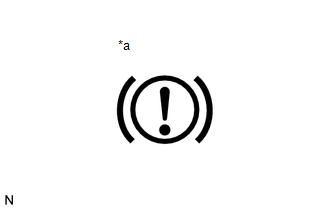 |
|
*a | Brake Warning Light (Yellow) | | |
(e) Bleed the brake line.(*3)
| (1) Remove the brake master cylinder reservoir filler cap assembly. |
|
(2) Remove the rear disc brake bleeder plug cap.
(3) Connect a vinyl tube to the rear disc brake bleeder plug.
(4) Add brake fluid to the reservoir until the fluid level is between the MAX and MIN lines on the brake fluid reservoir.(*a)
(5) Depress the brake pedal several times, and then loosen the bleeder plug with the pedal depressed.(*b)
(6) When fluid stops coming out, tighten the rear disc brake bleeder plug and release the brake pedal.(*c)
(7) Repeat steps (*a) through (*c) until there are no signs of air in the brake fluid.
(f) Repeat steps (*1) through (*3) 3 times.
NOTICE:
If
there is still air in the system after performing steps (*1) through
(*3) 3 times, repeat the steps (*1) through (*3) until the air has been
bled.
(g) Tighten the rear disc brake bleeder plug completely.
Torque:
8.3 N·m {85 kgf·cm, 73 in·lbf}
(h) Install the rear disc brake bleeder plug cap to the rear disc brake bleeder plug.
(i)
Hold the 2 rear disc brake cylinder slide pins, and install the rear
disc brake cylinder assembly to the rear disc brake cylinder mounting
with 2 new bolts.
Torque:
34.3 N·m {350 kgf·cm, 25 ft·lbf}
(j) Inspect for brake fluid leaks.
(k) Adjust the brake fluid level in the reservoir.
Click here 
(l) Install the brake master cylinder reservoir filler cap assembly.
(m) Turn the power switch off.
(n) Clear the DTCs.
Click here

16. INSTALL REAR WHEEL
Click here

17. NORMAL CONDITION RECOVERY
for HV Model: Click here

for Gasoline Model: Click here

Removal
REMOVAL
CAUTION / NOTICE / HINT
The
necessary procedures (adjustment, calibration, initialization, or
registration) that must be performed after parts are removed and
installed, or replaced during rear brake removal/installation are shown
below.
Necessary Procedures After Parts Removed/Installed/Replaced |
Replaced Part or Performed Procedure |
Necessary Procedure | Effect/Inoperative Function when Necessary Procedure not Performed |
Link |
|
*1: for HV Model
*2: When performing learning using the Techstream. Click here
 |
|
Auxiliary battery terminal is disconnected/reconnected*1 |
Perform steering sensor zero point calibration |
Lane Departure Alert System (w/ Steering Control) |
 |
|
Pre-collision System |
|
Intelligent Clearance Sonar System*2 |
|
Lighting System (for HV Model with Cornering Light) |
|
Memorize steering angle neutral point |
Parking Assist Monitor System |
 |
|
Panoramic View Monitor System |
 |
NOTICE:
- Immediately after installing the brake pads, the braking performance may
be reduced. Always perform a road test in a safe place while paying
attention to the surroundings.
- After replacing the rear disc brake pads, always perform a road test to check the braking performance and check for vibrations.
- When the brake pedal is first depressed after replacing the brake pads
or pushing back the disc brake piston, DTC C1214 may be stored. As there
is no malfunction, clear the DTC. (for HV Model)
- While the auxiliary battery is connected, even if the power switch is
off, the brake control system activates when the brake pedal is
depressed or any door courtesy switch turns on. Therefore, when
servicing the brake system components, do not operate the brake pedal or
open/close the doors while the auxiliary battery is connected. (for HV
Model)
HINT:
- Use the same procedure for the RH side and LH side.
- The following procedure is for the LH side.
PROCEDURE
1. PRECAUTION (for HV Model)
NOTICE:
- After turning the power switch off, waiting time may be required before
disconnecting the cable from the negative (-) auxiliary battery
terminal. Therefore, make sure to read the disconnecting the cable from
the negative (-) auxiliary battery terminal notices before proceeding
with work.
Click here 
- Make sure to read the precautions of the electric parking brake system before removing the rear brake assembly.
Click here 
2. REMOVE REAR WHEEL
Click here 
3. PERFORM REAR BRAKE PAD REPLACEMENT MODE
for Gasoline Model: Click here

for HV Model: Click here

4. DISABLE BRAKE CONTROL (for HV Model)
(a) Wait at least 2 minutes after turning the power switch off.
NOTICE:
- When the brake pedal is depressed or the door courtesy switch is turned
on even if the power switch is off, the brake control system activates.
Therefore do not depress the brake pedal or open/close the doors until
the reservoir level switch connector is disconnected.
- Do not operate the electric parking brake switch assembly when the
electric parking brake system is in rear brake pad replacement mode.
| (b) Disconnect the reservoir level switch connector. |
|
(c) Disconnect the cable from the negative (-) auxiliary battery terminal.
Click here 
(d) Depress the brake pedal 40 times or more to return all the fluid in the accumulator back to the reservoir.
(e) Check that the brake pedal cannot be further depressed.
5. DRAIN BRAKE FLUID
NOTICE:
If brake fluid leaks onto any painted surface, immediately wash it off.
6. SEPARATE REAR FLEXIBLE HOSE
| (a) Remove the union bolt and gasket, and disconnect the rear flexible hose from the rear disc brake cylinder assembly. |
|
7. DISCONNECT NO. 2 PARKING BRAKE WIRE ASSEMBLY
Click here

8. REMOVE PARKING BRAKE ACTUATOR ASSEMBLY
Click here 
9. REMOVE REAR DISC BRAKE CYLINDER ASSEMBLY
| (a) Hold the 2 rear disc brake cylinder slide pins and remove the 2 bolts and rear disc brake cylinder assembly. |
|
10. REMOVE REAR DISC BRAKE PAD
| (a) Remove the 2 rear disc brake pads from the rear disc brake cylinder mounting. |
|
11. REMOVE REAR DISC BRAKE ANTI-SQUEAL SHIM KIT
Click here

12. REMOVE REAR DISC BRAKE PAD SUPPORT PLATE
| (a) Remove the 4 rear disc brake pad support plates from the rear disc brake cylinder mounting.
NOTICE: Each
rear disc brake pad support plate has a different shape. Be sure to put
an identification mark on each rear disc brake pad support plate so
that it can be reinstalled to its original position. | |
13. REMOVE REAR DISC BRAKE CYLINDER SLIDE PIN
| (a)
Remove the rear No. 1 disc brake cylinder slide pin and rear No. 2 disc
brake cylinder slide pin from the rear disc brake cylinder mounting. |
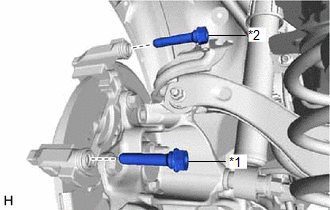 |
|
*1 | Rear No. 1 Disc Brake Cylinder Slide Pin | |
*2 | Rear No. 2 Disc Brake Cylinder Slide Pin | | |
| (b)
Using a screwdriver with its tip wrapped with protective tape, remove
the rear disc brake cylinder slide bushing from the rear No. 2 disc
brake cylinder slide pin. NOTICE: Do not damage the rear No. 2 disc brake cylinder slide pin. |
|
14. REMOVE REAR DISC BRAKE BUSHING DUST BOOT
| (a) Remove the 2 rear disc brake bushing dust boots from the rear disc brake cylinder mounting. |
|
15. REMOVE REAR DISC BRAKE CYLINDER MOUNTING
| (a) Remove the 2 bolts and rear disc brake cylinder mounting. |
|
16. REMOVE REAR DISC
| (a) Put matchmarks on the rear disc and rear axle hub and bearing assembly. |
|
(b) Remove the rear disc.
